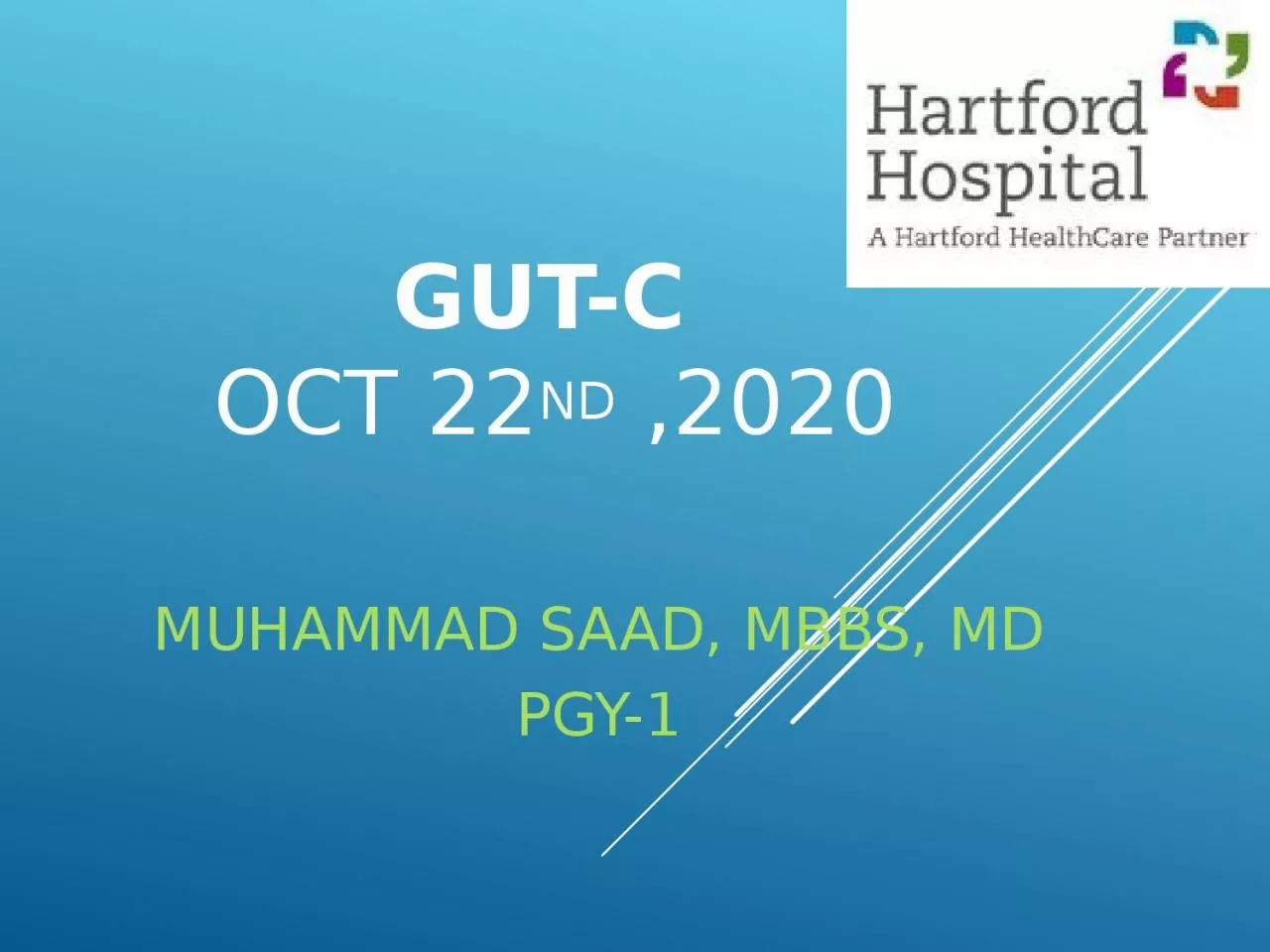

PGY1 CLINICAL HISTORY 3 yo male co of morning emesis Intermittent abdominal pain Polyuria and Polydipsia No fever or chills Abdominal MRI 921 showed 37 x 28 x 33 cm hepatic lesion ID: 927648
Download Presentation The PPT/PDF document "GUT-C OCT 22 ND ,2020 MUHAMMAD SAAD, M..." is the property of its rightful owner. Permission is granted to download and print the materials on this web site for personal, non-commercial use only, and to display it on your personal computer provided you do not modify the materials and that you retain all copyright notices contained in the materials. By downloading content from our website, you accept the terms of this agreement.
Slide1
GUT-C OCT 22ND ,2020
MUHAMMAD SAAD, MBBS, MDPGY-1
Slide2CLINICAL HISTORY3 y/o male c/o of morning emesis, Intermittent abdominal pain, Polyuria and Polydipsia.
No fever or chills.
Slide3Abdominal MRI (9/21): showed 3.7 x 2.8 x 3.3 cm hepatic lesion in segment 6 with associated internal cystic areas.
Slide4Labs:AST: 39 (10-55 U/L)ALT: 13 (10-55 U/L)
ALP: 244 (104 - 345 U/L)GGT: 18 (11-50 U/L)LDH: 259 (120-300 U/L)AFP TUMOR MARKER: 2.2 (0.5-7.9 ng/mL)
BILE ACID, TOTAL: 15 (0-19
u
mol
/L)
Slide5HISTOLOGICAL IMAGES
Slide6Slide7Slide8Slide9Slide10Slide11Slide12WHAT DO YOU THINK???
Slide13IMMUNOHISTOCHEMISTRY?????
Slide14s100
CD1a
Slide15DIAGNOSIS????
Slide16DIFFERENTIAL DIAGNOSISLANGERHANS CELL HISTIOCYTOSISPRIMARY SCLEROSING CHOLANGITIS
LANGERHANS CELL SARCOMAROSAI DORFMANN DISEASE
Slide17LANGERHANS CELL HISTIOCYTOSISFINAL DIAGNOSIS
Slide18Recent PMHx/PSHx He initially presented in July 2020 with left leg/hip pain and limp and was noted to have a cyst-like lesion in proximal left femur in subtrochanteric area.
He underwent open biopsy and curettage with grafting of left femur on 7/30. The bone biopsy shows Langerhans cell histiocytosis (LCH)
Slide19PET scan (9/4) showed: 1) FDG avid lesion in the metaphysis of left proximal femur 2) multiple FDG avid foci in right lower liver lobe
Abdominal MRI (9/21): showed 3.7 x 2.8 x 3.3 cm hepatic lesion in segment 6 with associated internal cystic areas.
Due to the PET and MRI findings. Patient underwent Liver core biopsy on
10/8.
Slide20HistoryHistiocytosis was first described in the medical literature in the mid to late 1800s. Through the years, it has been known by various names, such as histiocytosis X, eosinophilic granuloma, Letterer-Siwe disease, Hashimoto-Pritzker disease, and Hand-Schüller-Christian syndrome.
In 1973, the name Langerhans cell histiocytosis (LCH) was introduced. This name was agreed upon to recognize the central role of the Langerhans cell.
Slide21EpidemiologyIncidence in children:2-5 per million per year in children
Incidence in adults:One adult per million per year in adults
Slide22Site Unisystem disease most often involves bone followed by skin, lymph node, and lung.
Multisystem disease involves skin, bone, liver, spleen, bone marrow lymph glands, lung, brain and pituitary gland.
what is the most common endocrine manifestation of CNS involvement in Langerhans cell histiocytosis?
Slide23It is subdivided into low and high risk according to involvement of "risk" organsHigh-risk organs: Liver, spleen, bone marrowLiver involvement: 10-15%
Involvement of High risk organs is associated with poor prognosis.3-year survival decreases from 96.7% to 51.8% with liver involvement
Slide24ControversyIs LCH a reactive process or a neoplasm???
Slide25Etiology/PathogenesisLangerhans cell histiocytosis (LCH) is marked by proliferation of Langerhans-type cells that share immunophenotypic and ultrastructural similarities with antigen-presenting Langerhans cells of mucosal sites and skin.
It was hypothesized that the disease originated from epidermal Langerhans cells due to the resemblance.
Slide26However, more recent studies using cell-specific gene expression profiling suggest that LCH arises from bone marrow–derived immature myeloid dendritic cells rather than from epidermal Langerhans cells.
The molecular pathogenesis of this disease supports its categorization as a neoplasm.BRAF V600E mutations seen in 25-64% of cases
MAP2K1
mutations seen in 27.5% of cases
Slide27Histological FeaturesThe lesions of LCH are composed of cells that are 12 to 15 μm in diameter with abundant eosinophilic cytoplasm.
The nuclei of LCH cells are irregular with prominent folds and grooves, fine chromatin, and indistinct nucleoli.
Slide28Background eosinophils, lymphocytes, histiocytes, and neutrophils are often present in variable quantities. When present within lymph nodes, LCH is often characterized by sinusoidal involvement.
Slide29Infiltration of portal tracts and lobules
Slide30Bile duct infiltration and destructionDisplacement or replacement of duct epithelial cells by Langerhans cellsPortal, periportal and periductal concentric fibrosis, duct loss, ductular
reactionMay progress to biliary cirrhosis
Slide31IHCThe characteristic immunophenotype of LCH includes expression of CD1a, S100 protein, and langerin (CD207). Expression of CD68 is variable
CD1AS100
Slide32ELECTRON MICROSCOPIC IMAGE
Slide33DIFFERENTIAL DIAGNOSISPRIMARY SCLEROSING CHOLANGITISLANGERHANS CELL SARCOMAROSAI DORFMANN DISEASE
Slide34Primary Sclerosing CholangitisPredilection for young and middle-aged menElevated alkaline phosphatase in over 90% of patientsConcentric fibrosis around affected bile ducts with onion skin appearance.
Slide35Lymphocytic cholangitisDegeneration and atrophy of duct epitheliumPeriportal copper deposition indicates chronic cholestasis
Slide36LANGERHANS CELL SARCOMALesion looks like sarcomaOvertly malignant cytologic features
Extensive coagulative necrosisExtremely high mitotic rate, > 30/10 HPFAtypical mitotic figures
Slide37Immunophenotypic features may distinguish LCS from LCH.
Slide38ROSAI DORFMANN DISEASERosai-Dorfman disease (RDD) and sinus histiocytosis with massive lymphadenopathy are equivalent terms.Typically presents with bilateral, painless cervical lymphadenopathy, although extranodal disease of head and neck is common
Slide39Numerous histiocytes with abundant clear to eosinophilic cytoplasm and vesicular nuclei, also sheets of lymphocytes and plasma cells with emperipolesis (phagocytosis of intact lymphocytes and plasma cells)Immunohistochemistry: S100(+), CD1a(-)
Slide40REFERENCES:Berres, Marie‐Luise
, Miriam Merad, and Carl E. Allen. "Progress in understanding the pathogenesis of Langerhans cell histiocytosis: back to Histiocytosis X?." British journal of haematology 169.1 (2015): 3-13.Rodriguez-Galindo, Carlos, and Carl E. Allen. "Langerhans cell histiocytosis."
Blood, The Journal of the American Society of Hematology
135.16 (2020): 1319-1331.
Harmon, Charles M., and Noah Brown. "Langerhans cell histiocytosis: a clinicopathologic review and molecular pathogenetic update."
Archives of pathology & laboratory medicine
139.10 (2015): 1211-1214.
Li, Hua, et al. "Hepatic Langerhans Cell Histiocytosis (LCH) Presenting as a Harbinger of Multisystem LCH."
Cureus
12.6 (2020
).
Kaplan, Keith J., Zachary D. Goodman, and Kamal G. Ishak. "Liver involvement in Langerhans' cell histiocytosis: a study of nine cases."
Modern pathology
12.4 (1999): 370-378
.
https://
app.expertpath.com/document/langerhans-cell-histiocytosis/1340413b-78c4-4ab7-87f4-222f8d0fe784?searchTerm=langerhans+cell+histiocytosis+liver
Slide41Questions?
Slide42THANK YOU